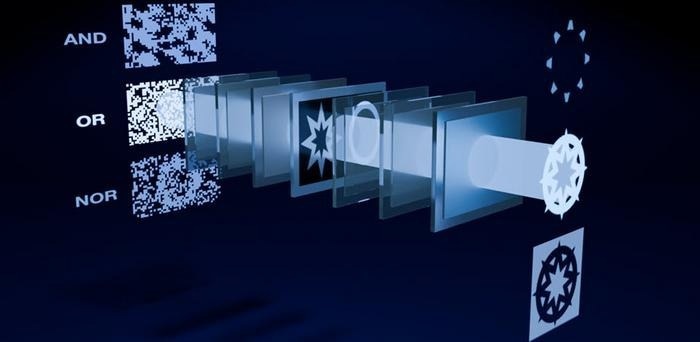Reviewed by Danielle Ellis, B.Sc.Oct 7 2024
Researchers from the University of Tokyo's Information Photonics Lab have made noteworthy advancements in optical computing by creating a unique optical computation architecture known as “diffraction casting.” This approach, described in the journal Advanced Photonics, expands upon the idea of spatial parallelism of light, which was initially investigated in the 1980s using a process called “shadow casting.”
 Diffraction casting enables scalable and paralleled logic operations with high flexibility and integration capability, based on wave optics. Image Credit: Conceptual artwork courtesy of Ryosuke Mashiko et al. (University of Tokyo).
Diffraction casting enables scalable and paralleled logic operations with high flexibility and integration capability, based on wave optics. Image Credit: Conceptual artwork courtesy of Ryosuke Mashiko et al. (University of Tokyo).
The Internet of Things (IoT) and artificial intelligence (AI) have grown at lightning speed in recent years, increasing the demand for computing power. Traditional electronic computing, however, is nearing its performance limits, as anticipated by Moore's Law, which predicts that the number of transistors on a microchip doubles roughly every two years.
The need to find new computer paradigms that can keep up with the growing demands for energy economy, speed, and scale has resulted from this. Optical computing, which uses the special qualities of light to carry out calculations, is one interesting direction.
Although shadow casting offered insightful information, its dependence on geometrical optics constrained its flexibility and integration capabilities.
The novel diffraction casting method overcomes these restrictions by utilizing wave optics. Diffraction and interference are two examples of the wave characteristics and spatial parallelism that layers of diffractive optical elements are trained to take advantage of.
This enables very flexible and integrated parallel logic operations that are scalable. There is no need to encode and decode inputs and outputs because the operations can be changed just by adjusting the lighting patterns.
Impressive results have been obtained from numerical demonstrations of diffraction casting, which achieve all 16 logic operations at the speed of light and without error on two random 256-bit parallel binary inputs.
This architecture is a strong contender for next-generation computer systems since it provides notable benefits in terms of integration and scalability. Its adaptability and reconfigurability make numerous applications, including image processing and optical computing accelerators, possible.
This study, a component of the Grant-in-Aid for Transformative Research Areas project headed by Waseda University Professor Tetsuya Kawanishi, demonstrates the potential of spatial parallelism in optical computing as a building block for the development of future computing systems.
It also establishes the foundation for a novel framework for information processing that combines computation, sensing, and imaging and has the potential to grow into other domains.
Journal Reference:
Mashiko, R., et al. (2024) Diffraction casting. Advanced Photonics. doi.org/10.1117/1.ap.6.5.056005.